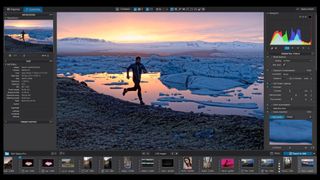


Every application that I own that has an activation limit all have some means for the user to de-activate an installation immediately. It’s more conceivable to use Lightroom for library management and OpticsPro for image processing, but it still complicates the workflow.I would also add to the request as well. We found that the drawbacks of interrupting the non-destructive workflow outweighed the benefits of accessing both applications’ best features. However, this is only possible by writing all edits to a new file before transfer. This is easier in version 10, thanks to a Lightroom plugin that simplifies transferring files between the two applications. One solution is to run both applications side by side.

However, as regular Lightroom users, we missed being able to apply independent colour-correction settings to different parts of the frame. Smart Lighting and ClearView provide a superb starting point from which to fine-tune raw files, and they go a long way towards making up for the lack of localised editing tools. Fortunately, this isn’t enabled by default.
#DXO OPTICS PRO 10 MANUAL SKIN#
The effect doesn’t flatter skin tones, either, even at modest settings, turning them dark and mottled. You’ll need to be careful with the Intensity slider, though: too much, and photos take on a surreal appearance, especially when combined with Smart Lighting. However, it performed better than Lightroom’s sharpening filter when tackling soft focus towards the edges of frames. This sharpening algorithm is apparently improved in this update, although the difference to version 9 was too subtle for us to spot. These profiles also include focus, so that sharpening can be applied dynamically to photos. One of OpticPro’s key strengths is its database of lens profiles, which allows it to correct for geometry, chromatic aberrations and vignetting. Comparing Lightroom and DxO Prime for noise-reduction quality, Prime sometimes had a tiny advantage. It’s still around twice as slow as Lightroom’s exports, though. In practice, it makes sense to stick with the older, less processor-intensive algorithm for all but the noisiest images here, exports took less than 30 seconds per image. Even so, exports still came in at between one and five minutes per image. Performance is much improved this time around – between two and five times faster in our tests. Its results were excellent but it was painfully slow to process photos. The Prime noise-reduction algorithm was a major new feature in version 9. It isn’t so up-to-date for other camera brands, though, with no mention of the Samsung NX1, NX3000 or NX mini, and no new Fujifilm cameras added since 2011. Support for the Canon 7D Mark II is scheduled for December 2014. It already supports the Nikon D750 and D810, Sony A77 II and A5100, all of which were announced within the last six months. We appreciate timely support for new cameras’ raw files, and Optics Pro generally scores well here.
#DXO OPTICS PRO 10 MANUAL UPGRADE#
This means Optics Pro 9 Standard users must upgrade to OpticsPro 10 Elite to avoid losing features. Anti-moiré, ICC profile management and a handful of other features are missing, too. It omits the Prime noise-reduction algorithm and the new ClearView contrast-manipulation tool – more on both of these below.


 0 kommentar(er)
0 kommentar(er)
